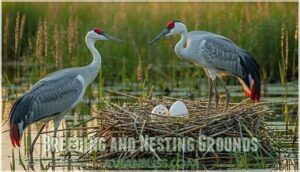This site is supported by our readers. We may earn a commission, at no cost to you, if you purchase through links.

These magnificent birds undertake epic migrations spanning thousands of miles, from Alaska’s breeding grounds to southern wintering areas.
They’re omnivores, shifting from protein-rich invertebrates during breeding season to waste grains during migration.
Their haunting, trumpeting calls can be heard for miles as they gather in massive flocks of up to 650,000 individuals at famous stopover sites.
With seven-foot wingspans and elaborate courtship dances, sandhill cranes create one of nature’s most spectacular wildlife phenomena.
Knowing their patterns reveals the best viewing opportunities.
Table Of Contents
- Key Takeaways
- Sandhill Crane Characteristics
- Sandhill Crane Habitat and Range
- Sandhill Crane Diet and Foraging
- Sandhill Crane Migration and Populations
- Viewing and Conserving Sandhill Cranes
- Frequently Asked Questions (FAQs)
- Are sandhill cranes migratory?
- What does a sandhill crane look like?
- Where do sandhill cranes live?
- What is a sandhill crane?
- Are there sandhill cranes in New Brunswick?
- How old do sandhill cranes get?
- Why are sandhill cranes so special?
- Why are Sandhill Crane illegal in Florida?
- What states do sandhill cranes live in?
- What does it mean when you see a sandhill crane?
- Conclusion
Key Takeaways
- You’ll recognize sandhill cranes by their 4-foot height, gray plumage, and distinctive red crown patch that makes them unmistakable in North America’s wetlands and grasslands.
- You can witness one of nature’s most spectacular migrations when up to 600,000 cranes gather along Nebraska’s Platte River each spring, traveling up to 4,000 miles between breeding and wintering grounds.
- You’ll find these adaptable birds shift their diet seasonally from protein-rich insects during breeding to waste grains during migration, using their long bills to probe wetlands and agricultural fields.
- You’re seeing living dinosaurs that’ve survived 15 million years – they mate for life, perform elaborate courtship dances, and create trumpeting calls that carry for miles across their ancient flyway routes.
Sandhill Crane Characteristics
You’ll easily recognize these magnificent birds by their towering height of up to four feet and distinctive gray plumage with rusty-brown patches.
Their bright red crown patch and unique "bustle" of drooping tail feathers make them unmistakable in wetlands and grasslands.
Physical Description and Traits
You’ll easily recognize sandhill cranes by their impressive size and distinctive features.
These majestic birds stand out with their towering height and elegant silhouette.
Key physical traits include:
- Size and measurements – Standing 3-4 feet tall with 6-foot wingspans
- Color pattern – Gray plumage with rusty wash on upperparts
- Distinctive markings – Red crown patch and white cheek in adults
- Leg coloration – Black legs supporting their substantial frame.
Plumage variations differ between ages, with juvenile traits including brownish heads lacking the adult’s red crown.
Size differences exist among subspecies, while wingspan ratio remains consistent across populations.
Behavioral Patterns and Habits
You’ll observe fascinating social behavior patterns when watching sandhill cranes throughout their daily routines.
Watching these graceful giants reveals nature’s most captivating social choreography in motion.
These magnificent birds engage in complex mating rituals including synchronized courtship dances with dramatic leaps and wing displays.
Their distinctive vocalizations carry for miles, helping coordinate flock movements and maintain pair bonds during foraging activities.
Like the sandhill crane, the taller whooping crane also exhibits elaborate courtship rituals.
| Behavior Type | Description | Season |
|---|---|---|
| Mating Dances | Synchronized jumps, wing stretches, head bobs | Spring |
| Daily Activities | Feeding, preening, body shaking, head rubbing | Year-round |
| Aggression Displays | Upright postures, stabbing motions, territorial kicks | Breeding |
Distinctive Features and Markings
You’ll spot a Sandhill Crane by its unmistakable red crown and slate-gray plumage variations that shift with age and season.
These distinctive features make bird identification straightforward when you know what to look for in their color, shape, and description.
- Red Crown: Bright crimson patch on adults’ foreheads, absent in juveniles
- Bustle Feathers: Drooping plumes creating a distinctive "bustle" around the tail
- Size Differences: Range from 34-48 inches tall with notable subspecies variations
- Juvenile Markings: Rusty-brown coloring without the signature red crown patch
- Gray Plumage: Slate-gray body with rusty wash on back and wings
Sandhill Crane Habitat and Range
You’ll find sandhill cranes across diverse habitats from Arctic tundra to southern wetlands, making them one of North America’s most widespread birds.
These adaptable giants follow ancient migration routes that span thousands of miles, connecting their northern breeding grounds to warmer wintering areas, which is a remarkable example of ancient migration.
Breeding and Nesting Grounds
Sandhill Cranes choose nesting grounds in shallow wetlands where they’ll have privacy and protection.
You’ll find their nests in marshes, wet meadows, and grasslands across northern regions. These birds build platform nests using marsh vegetation and plant material gathered from their surroundings.
To enhance viewing opportunities, consider investing in essential viewing equipment.
| Nesting Aspect | Details |
|---|---|
| Nest Site Selection | Isolated marshes, wet meadows, shallow water areas |
| Nest Construction | Platform-style using reeds, sedges, grasses |
| Egg Laying | Typically 2 eggs, occasionally 1-3 |
| Chick Development | Leave nest within 24 hours, fledge at 65-75 days |
| Parental Care | Both parents incubate for 29-32 days, guide young for 9-10 months |
Migration Patterns and Routes
Migratory journeys span thousands of miles as these majestic birds follow ancient pathways.
You’ll witness incredible crane migration patterns along these major flyway routes:
- Central Flyway – 80% of North America’s population travels through Nebraska’s Platte River
- Distance traveled – Lesser cranes cover up to 4,000 miles from Arctic to Mexico
- Stopover ecology – Birds gain 5-15% body weight at key refueling sites
- Climate impacts – Changing weather shifts traditional migration timing and flock dynamics
During migration, cranes often face powerline collision risks.
Wintering and Roosting Sites
After completing their epic migration journey, these magnificent birds settle into carefully chosen wintering areas across the southeastern and southwestern United States.
You’ll find massive flocks congregating in Florida’s wetlands, California’s Central Valley, and northern Mexico, where they display remarkable site fidelity—returning to the same locations year after year.
The cranes’ movements are often timed with seasonal hydrologic cycles that are important to agricultural communities.
| Wintering Region | Key Features |
|---|---|
| Platte River, Nebraska | 600,000+ birds gather during spring migration |
| Florida Wetlands | Year-round residents with high site fidelity |
| California’s Central Valley | 61% of Greater Sandhill crane population winters here |
| Arizona/Mexico Border | Critical habitat for Lower Colorado River Valley population |
Their roosting behavior reveals fascinating site selection criteria.
These birds prefer flowing river channels with shallow water depths between 5-24 centimeters, choosing spots far from human disturbance.
Habitat protection efforts focus on maintaining open channels with low bank vegetation, as woody encroachment threatens traditional roosting areas essential for flock survival.
Sandhill Crane Diet and Foraging
You’ll discover that sandhill cranes maintain a remarkably flexible diet that shifts throughout the year.
These adaptable birds use their long bills to probe wetlands and fields, switching from plant-heavy meals in winter to protein-rich foods during breeding season.
Omnivorous Diet and Food Sources
You’ll find that sandhill cranes aren’t picky eaters – their omnivorous diet includes everything from cultivated grains and wetland roots to insects and small prey.
These adaptable birds consume about 90% plant material, including corn, wheat, berries, and tubers they discover through wetland probing.
Seasonal foods shift their preferences, with insect consumption increasing during breeding season while crop consumption dominates migration periods, showcasing remarkable prey variety.
Foraging Techniques and Strategies
Probing techniques define how these birds extract hidden treasures from wetland substrates.
You’ll observe their long bills penetrating mud and shallow water with precision, locating subsurface roots and invertebrates.
Flock foraging maximizes efficiency during migration, with hundreds scanning fields simultaneously.
Their omnivorous nature drives sophisticated diet adaptations, switching between crop consumption in agricultural areas and insect hunting in marshes.
This feeding behavior demonstrates remarkable flexibility across diverse habitats.
To further enrich their environment, consider specialized crane enrichment for sophisticated diet adaptations and diverse habitats, showcasing their ability to adapt with precision and efficiency.
Seasonal Variations in Diet
A crane’s diet changes dramatically throughout the year as their nutritional needs shift.
You’ll notice distinct feeding behavior patterns that match seasonal availability and energy demands.
- Winter Food focuses on energy-dense tubers and acorns for survival
- Spring Diet emphasizes carbohydrates to fuel long migrations
- Summer Insects provide essential protein for breeding adults and growing chicks
- Autumn Grains from agricultural fields supply migration fuel
Regional differences affect food sources substantially across their range.
Sandhill Crane Migration and Populations
You’ll witness one of nature’s most spectacular migrations as sandhill cranes travel up to 4,000 miles twice annually, with an estimated 600,000 birds gathering along Nebraska’s Platte River each spring.
These remarkable populations follow ancient flyways that have remained unchanged for millions of years, making their journey one of the longest and most predictable wildlife movements in North America, with a path that is highly predictable.
Migratory Patterns and Routes
Along the great highways of North America, these birds follow ancient flyway routes that span thousands of miles.
Migration routes carved by time itself guide these ancient travelers across continents, following pathways older than human memory.
Migration distances reach up to 4,000 miles twice yearly, with flock dynamics creating impressive formations.
Climate impacts increasingly affect traditional stopover ecology sites.
Migratory bird patterns concentrate along the Central Flyway, where bird migration routes funnel through Nebraska’s Platte River valley, hosting 80% of the population during spring migration.
They utilize magnetic orientation skills for navigation.
Population Distribution and Abundance
Where do you find the world’s most abundant cranes? Sandhill crane populations reach approximately 1.45 million birds globally, making them more numerous than all other crane species combined.
The Mid-Continent Population peaked at 736,000 birds in Nebraska’s Central Platte River Valley during spring 2025. Regional variations show Eastern Population growth rates of 9.6% annually, while population monitoring reveals shifting distribution patterns affecting habitat management strategies, which impact the overall population monitoring.
Conservation Status and Threats
Despite stable overall populations, you’ll find sandhill cranes face growing challenges.
Habitat loss threatens breeding grounds as wetlands disappear to agriculture and development.
Climate change shifts migration timing and dries vital wetlands.
Power lines cause collision deaths during migration.
Hunting regulations vary by state, with some subspecies like Florida cranes remaining endangered species requiring focused conservation efforts.
Viewing and Conserving Sandhill Cranes
You’ll discover some of the world’s most spectacular wildlife viewing opportunities when sandhill cranes gather in massive flocks during migration seasons.
However, these magnificent birds face ongoing conservation challenges that require dedicated protection efforts to guarantee future generations can witness their ancient migration patterns, which involve spectacular displays of nature.
Best Locations for Viewing
Spectacular crane gatherings create unforgettable birding hotspots across the Great Plains.
You’ll witness nature’s grandest show at these premier destinations:
- Platte River, Nebraska – Nearly 80% of the world’s population congregates here each spring, with Rowe Sanctuary offering prime viewing opportunities
- Monte Vista, Colorado – Over 20,000 cranes stage in San Luis Valley’s wetland habitat during March migration
- Bosque del Apache, New Mexico – Thousands winter here from November through February in protected bird habitats.
Many seek crane related products for their tours.
Conservation Efforts and Initiatives
Dedicated champions work tirelessly to protect these magnificent birds.
You’ll find habitat preservation and wetland restoration projects spanning millions of acres.
Bird conservation organizations coordinate hunting regulations while reducing collisions through powerline markers.
Public awareness campaigns and bird conservation initiatives educate communities about protecting crane habitats.
| Conservation Focus | Key Results |
|---|---|
| Habitat Preservation | 2+ million acres protected |
| Wetland Restoration | 80% population uses Platte River |
| Collision Reduction | 1,200+ miles of safe powerlines |
| Public Awareness | 33,000+ festival visitors annually |
Threats and Challenges to Conservation
Sandhill cranes face mounting conservation challenges that threaten their future survival.
You’ll witness these magnificent crane birds struggling against multiple pressures across their range. Climate change disrupts traditional wetlands, while habitat loss eliminates essential stopover sites during migration.
Major threats include:
- Habitat Loss – Development destroys wetlands and grasslands essential for breeding
- Climate Change – Altered weather patterns affect migration timing and food availability
- Collisions – Power lines and wind turbines cause significant mortality during flight
- Disease Outbreaks – Crowded roosting sites enable rapid spread of avian diseases
Hunting pressure remains controlled, but wetlands conservation efforts struggle against agricultural expansion.
These conservation status concerns require coordinated bird conservation strategies to protect remaining habitats and migration corridors. Habitat destruction contributes to seventy-eight percent extinction risk for bird species.
Frequently Asked Questions (FAQs)
Are sandhill cranes migratory?
Like birds of passage following ancient paths, you’ll find these magnificent creatures are indeed migratory.
Most sandhill cranes travel thousands of miles between breeding and wintering grounds, though some populations stay put year-round, exhibiting a unique aspect of their behavior.
What does a sandhill crane look like?
You’ll spot a tall, gray bird standing three to four feet high with a distinctive red crown patch on its forehead.
It has long black legs, a dark bill, and drooping feathers that create a bustle-like appearance around its back end.
Where do sandhill cranes live?
You’ll find these magnificent birds across North America, from Alaska’s tundra to Florida’s wetlands.
They nest in northern marshes and grasslands, then migrate thousands of miles to warmer southern regions for winter.
What is a sandhill crane?
While you might think these birds are just oversized herons, sandhill cranes are actually ancient wading birds.
You’ll recognize them by their gray plumage, red crown, and impressive six-foot wingspan as they migrate thousands of miles annually.
Are there sandhill cranes in New Brunswick?
Yes, you’ll now find them in New Brunswick’s marshes and fields.
These large birds have recently become regular visitors to the Tantramar Marsh area, marking a notable expansion from their traditional prairie heartland.
How old do sandhill cranes get?
Incredibly, the oldest was at least 36 years, while most birds in the wild reach around 20 years or more. You’ll find their lifespans vary depending on whether they’re wild or captive.
Why are sandhill cranes so special?
You’re witnessing living dinosaurs that’ve survived 15 million years. These magnificent birds mate for life, perform elaborate courtship dances, and gather in flocks of 600,000 during migration—nature’s greatest spectacle.
Why are Sandhill Crane illegal in Florida?
Hunting these birds isn’t allowed because Florida lists them as a threatened species.
They remain legally protected from hunting in Florida since 1974 due to habitat loss and declining populations threatening their survival.
What states do sandhill cranes live in?
You’ll find these majestic birds across North America, from Alaska to Florida.
They breed in northern states like Alaska, Idaho, and Nebraska, then migrate through the Great Plains to winter in warmer regions.
What does it mean when you see a sandhill crane?
When you spot one, you’re witnessing a symbol of longevity and good fortune. These majestic birds represent patience, focus, and successful partnerships since they mate for life.
Conclusion
The early bird catches the worm" rings especially true for sandhill crane enthusiasts.
You’ll discover these remarkable birds offer unforgettable experiences when you know where and when to look.
Their massive migrations create spectacular viewing opportunities across North America’s flyways.
By understanding the sandhill crane’s habitat needs, seasonal patterns, and conservation challenges, you’re better equipped to witness their ancient rituals.
Supporting habitat protection guarantees future generations can marvel at these magnificent creatures’ trumpeting calls echoing across wetlands.
- https://extension.usu.edu/swaner/naturalist-news/sandhill-crane-migration
- https://www.nature.org/en-us/get-involved/how-to-help/animals-we-protect/sandhill-crane/
- https://www.audubon.org/field-guide/bird/sandhill-crane
- https://savingcranes.org/news/resources/top-ten-facts-crane-migration/
- https://www.nwf.org/Educational-Resources/Wildlife-Guide/Birds/Sandhill-Crane












